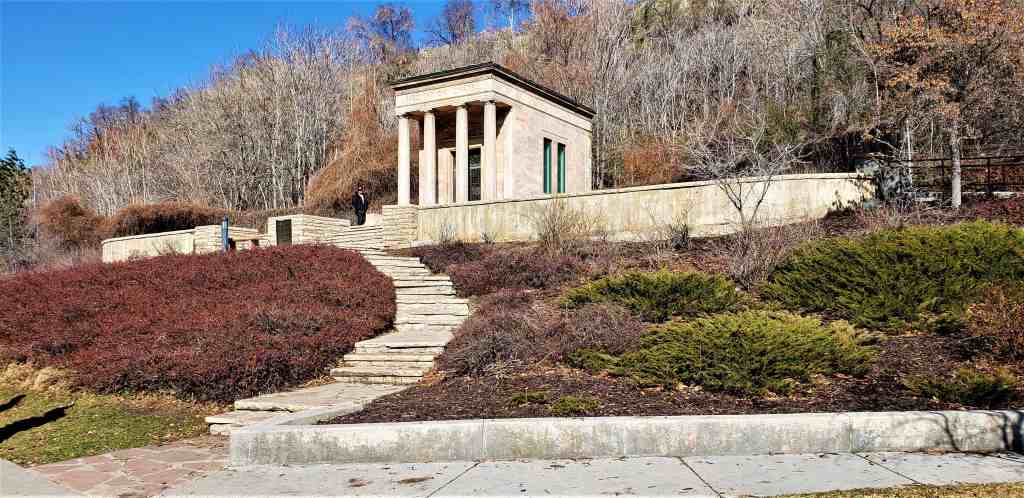(*)The beautiful Meditation Chapel is a space set apart for quiet reflection. Mr. and Mrs. Ross Beason built the chapel in 1948 as a memorial to their son, Ross Beason, Jr., and all other Utahns who died in World War II. The plaza surrounding the chapel contains more than 300 granite markers each representing a Utah serviceman whose remains were not recovered after the war. The pink marble chapel features intricate bronze doors, stunning “acid etched” windows, and a patterned marble floor. Take some time to enjoy the chapel’s contemplative atmosphere and lovely setting in Memory Grove Park.
Following World War II, Mr. and Mrs. Ross Beason offered to build a memorial to their son and other Utah sons who died in the war. Their son, Ross Beason, Jr.’s plane had been shot down off the coast of Italy. Mr. Beason had owned a financial house in Salt Lake from 1922-1932. Although he no longer lived in the state, he felt Utah was the appropriate place for the memorial.
The Meditation Chapel was designed by Paul Owan Davis, a Los Angeles architect. Taylor Wooley of Salt Lake City was the resident architect. The building was constructed of concrete and Italian marble. Mark B. Garff and Company contracted to do the labor and E. W. Hardy installed the marble. J. W. Askee was the superintendent of construction. Markers were placed around the memorial in honor of those Utah born citizens who died during World War II and when bodies were not recovered. The chapel was dedicated on July 24, 1948.
The Meditation Chapel somewhat resembles a Greek temple such as the temple of Nike Apteros in Athens. Having a tetraprostyle front with an inner portico or pronaos, from which entry is gained into the Chapel or Naos via a set of bronze rectangular sculptural doors.
The structure is rectangular measuring 16 feet by 28 feet. The construction medium is reinforced concrete covered with striated Georgian Marble ranging in color from pink to orange. The fluted ionic columns are monolithic marble having exceptional color and graining. The columns support an architrave frieze and cornice having no pediment but supporting a standing seam hipped copper roof.
The interior of the monument is surfaced in marble, the walls’are finished in Italian Botticino and the floor is laid in mosaic form composed of French and Italian marbles. The view into the interior is blocked by a delicately carved and inscribed marble bench seat having a tall straight back. The bench faces to the back or east end of the chapel where a marble chancel rail extends across the front of a white marble wall on which the poem “Immortality” is inscribed in gold lettering.
On either side of the chapel are two stained glass windows set side by side divided by a flat column. These windows being of exceptional quality and design depict a soldier, sailor, marine and army soldier.
Following World War II, Mr. and Mrs. Ross Beason offered to build a memorial to their son and other Utah sons who died in the war. Their son, Ross Beason, Jr.’s plane had been shot down off the coast of Italy. Mr. Beason had owned a financial house in Salt Lake from 1922-1932. Although he no longer lived in the state, he felt Utah was the appropriate place for the memorial.
The Meditation Chapel was designed by Paul Owan Davis, a Los Angeles architect. Taylor Wooley of Salt Lake City was the resident architect. The building was constructed of concrete and Italian marble. Mark B. Garff and Company contracted to do the labor and E. W. Hardy installed the marble. J. W. Askee was the superintendent of construction. Markers were placed aroung the memorial in honor of those Utah born citizens who died during World War II and when bodies were not recovered. The chapel was dedicated on July 24th, 1948.



